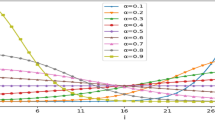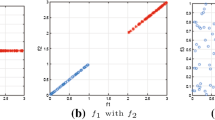Abstract
In this study, a novel method, fuzzy nearest neighbor partitioning (FNNP), is proposed for improving the classification capability of the neural network. For the original nearest neighbor partitioning method, the “short-sightedness defect” problem restrains the nearest neighbor partitioning method to learn valuable experience from the distribution information outside the samples’ nearest neighbors. Moreover, the noise sensitive problem that exists in the process of classifying the unknown samples further influences the performance of the nearest neighbor partitioning method. To overcome the short-sightedness defect problem, fuzzy logic theory is integrated into the FNNP, and promotes the ability that the FNNP learns experience from extensive distribution information. In addition, an improved classification strategy, which adopts the concept of the fuzzy nearest neighbor, is employed to increase the immunity of FNNP to noise when the unknown samples are classified. The proposed FNNP is compared with other classification methods for some famous datasets. The results of the experiments indicate that the proposed method achieves promising classification performance for various indicators.





Similar content being viewed by others
References
Do, T.D., Jin, C., Nguyen, V.H., Kim, H.: Mixture separability loss in a deep convolutional network for image classification. IET Image Process. 13(1), 135–141 (2019)
Gao, Z., Wu, Q., Chen, H., Qian, X., Wang, Y., Zhang, H.: Target classification by constructing fuzzy automata system. Int. J. Fuzzy Syst. 20(8), 2620–2631 (2018)
Kalia, H., Dehuri, S., Ghosh, A., Cho, S.-B.: Surrogate-assisted multi-objective genetic algorithms for fuzzy rule-based classification. Int. J. Fuzzy Syst. 20(6), 1938–1955 (2018)
Nandedkar, A.V., Biswas, P.K.: A fuzzy min–max neural network classifier with compensatory neuron architecture. IEEE Trans. Neural Netw. 18(1), 42–54 (2007)
Huang, W., Oh, S., Pedrycz, W.: Hybrid fuzzy wavelet neural networks architecture based on polynomial neural networks and fuzzy set/relation inference-based wavelet neurons. IEEE Trans. Neural Netw. Learn. Syst. 29(8), 3452–3462 (2018)
Chai, R., Ling, S.H., Hunter, G.P., Tran, Y., Nguyen, H.T.: Brain-computer interface classifier for wheelchair commands using neural network with fuzzy particle swarm optimization. IEEE J. Biomed. Health Inform. 18(5), 1614–1624 (2014)
Shang, H., Jiang, Z., Xu, R., Wang, D., Wu, P., Chen, Y.: The dynamic mechanism of a novel stochastic neural firing pattern observed in a real biological system. Cogn. Syst. Res. 53, 123–136 (2019)
Jiang, G., He, H., Yan, J., Xie, P.: Multiscale convolutional neural networks for fault diagnosis of wind turbine gearbox. IEEE Tran. Ind. Electron. 66(4), 3196–3207 (2019)
Chang, Y., Jung, C.: Single image reflection removal using convolutional neural networks. IEEE Trans. Image Process. 28(4), 1954–1966 (2019)
Hornik, K.: Approximation capabilities of multilayer feedforward networks. Neural Netw. 4(2), 251–257 (1991)
Adeli, H.: Neural networks in civil engineering: 1989–000. Comput. Aided Civil Infrastructure Eng. 16(2), 126–142 (2001)
Wang, L., Yang, B., Chen, Y., Abraham, A., Sun, H., Chen, Z., Wang, H.: Improvement of neural network classifier using floating centroids. Knowl. Inf. Syst. 31(3), 433–454 (2012)
Cai, C., Liu, S., Wang, L., Yang, B., Chen, Z., Zhou, J.: Optimizing floating centroids method neural network classifier using dynamic multilayer particle swarm optimization. In: Proceedings of the Genetic and Evolutionary Computation Conference, ser. GECCO ’18, pp. 394–401. ACM, New York (2018)
Wang, L., Zhu, X., Yang, B., Guo, J., Liu, S., Li, M., Zhu, J., Abraham, A.: Accelerating nearest neighbor partitioning neural network classifier based on cuda. Eng. Appl. Artif. Intell. 68, 53–62 (2018)
Wang, L., Yang, B., Chen, Y., Zhang, X., Orchard, J.: Improving neural-network classifiers using nearest neighbor partitioning. IEEE Trans. Neural Netw. Learn. Syst. 28(10), 2255–2267 (2017)
Xu, S., Liu, K., Li, X.: A fuzzy process neural network model and its application in process signal classification. Neurocomputing 335, 1–8 (2019)
Huang, W., Oh, S., Pedrycz, W.: Fuzzy wavelet polynomial neural networks: analysis and design. IEEE Trans. Fuzzy Syst. 25(5), 1329–1341 (2017)
Zhang, H., Liu, J., Ma, D., Wang, Z.: Data-core-based fuzzy min–max neural network for pattern classification. IEEE Trans. Neural Netw. 22(12), 2339–2352 (2011)
Chen, C.L.P., Liu, Z.: Broad learning system: an effective and efficient incremental learning system without the need for deep architecture. IEEE Trans. Neural Netw. Learning Syst. 29(1), 10–24 (2018)
Dietterich, T.G., Bakiri, G.: Solving multiclass learning problems via error-correcting output codes. J. Artif. Intell. Res. 2(1), 263–286 (1995)
Bagheri, M.A., Gao, Q., Escalera, S.: A genetic-based subspace analysis method for improving error-correcting output coding. Pattern Recognit. 46(10), 2830–2839 (2013)
Lachaize, M., Hrgarat-Mascle, S.L., Aldea, E., Maitrot, A., Reynaud, R.: Evidential framework for error correcting output code classification. Eng. Appl. Artif. Intell. 73, 10–21 (2018)
Yu, Z., Liu, Y., Yu, X., Pu, K.Q.: Scalable distributed processing of k nearest neighbor queries over moving objects. IEEE Trans. Knowl. Data Eng. 354(12), 4719–4738 (2015)
Zadeh, L.: Fuzzy sets. Inf. Control 8(3), 338–353 (1965)
Yang, M.-C., Wang, J.-Z., Sun, T.-Y.: Emd-based preprocessing with a fuzzy inference system and a fuzzy neural network to identify kiln coating collapse for predicting refractory failure in the cement process. Int. J. Fuzzy Syst. 20(8), 2640–2656 (2018)
Chen, Y., Zhang, Y., Shu, H., Yang, J., Luo, L., Coatrieux, J., Feng, Q.: Structure-adaptive fuzzy estimation for random-valued impulse noise suppression. IEEE Trans. Circuits Syst. Video Technol. 28(2), 414–427 (2018)
Huang, Y.-P., Singh, A., Liu, S.-I., Wu, S.-I., Quoc, H.A., Sereter, A.: Developing transformed fuzzy neural networks to enhance medical data classification accuracy. Int. J. Fuzzy Syst. 20(6), 1925–1937 (2018)
Kulkarni, A.D., Cavanaugh, C.D.: Fuzzy neural network models for classification. Appl. Intell. 12(3), 207–215 (2000)
Hoomod, H. K., abd ali, A.: Fuzzy-cellular neural network for face recognition HCI authentication. In: Journal of Physics: Conference Series, vol. 1003, pp. 12–33 (2018)
Chatzarakis, T.L.G.E.: Oscillation criteria for delay and advanced differential equations with nonmonotone arguments. Complexity 2018, 1–18 (2018)
Mohammed, M.F., Lim, C.P.: An enhanced fuzzy min–max neural network for pattern classification. IEEE Trans. Neural Netw. Learn. Syst. 26(3), 417–429 (2015)
Davtalab, R., Dezfoulian, M.H., Mansoorizadeh, M.: Multi-level fuzzy min–max neural network classifier. IEEE Trans. Neural Netw. Learn. Syst. 25(3), 470–482 (2014)
Melin, P., Miramontes, I., Prado-Arechiga, G.: A hybrid model based on modular neural networks and fuzzy systems for classification of blood pressure and hypertension risk diagnosis. Expert Syst. Appl. 107, 146–164 (2018)
Liu, S., Wang, L., Yang, B., Kong, S., Dong, H., Zhu, X.: Fuzzy nearest neighbor partitioning neural network for classification. In: 2018 International Conference on Security, Pattern Analysis, and Cybernetics (SPAC). IEEE, New York, (2018)
Liu, H., Li, S., Li, G., Wang, H.: Adaptive controller design for a class of uncertain fractional-order nonlinear systems: an adaptive fuzzy approach. Int. J. Fuzzy Syst. 20(2), 366–379 (2018)
Zhou, J., Chen, L., Chen, C.P., Zhang, Y., Li, H.X.: Fuzzy clustering with the entropy of attribute weights. Neurocomputing 198, 125–134 (2016)
Wang, N., Sun, Z., Zheng, Z., Zhao, H.: Finite-time sideslip observer-based adaptive fuzzy path-following control of underactuated marine vehicles with time-varying large sideslip. Int. J. Fuzzy Syst. 20(6), 1767–1778 (2018)
Chen, H.-L., Yang, B., Wang, G., Liu, J., Xu, X., Wang, S.-J., Liu, D.-Y.: A novel bankruptcy prediction model based on an adaptive fuzzy k-nearest neighbor method. Knowl. Based Syst. 24(8), 1348–1359 (2011)
Jensen, R., Cornelis, C.: Fuzzy-rough nearest neighbour classification. In: Peters, J.F., Skowron, A., Chan, C.C., Grzymala-Busse, J.W., Ziarko, W.P. (eds.) Transactions on Rough Sets XIII, pp. 56–72. Springer, Berlin (2011)
Derrac, J., Garcia, S., Herrera, F.: Fuzzy nearest neighbor algorithms: taxonomy, experimental analysis and prospects. Inf. Sci. 260, 98–119 (2014)
Wang, L., Yang, B., Wang, S., Liang, Z.: Building image feature kinetics for cement hydration using gene expression programming with similarity weight tournament selection. IEEE Tran. Evol. Comput. 19(5), 679–693 (2015)
Chen, C.L.P., Zhang, T., Chen, L., Tam, S.C.: I-ching divination evolutionary algorithm and its convergence analysis. IEEE Trans. Cybern. 47(1), 2–13 (2017)
Zhang, T., Chen, C.L.P., Chen, L., Xu, X., Hu, B.: Design of highly nonlinear substitution boxes based on i-ching operators. IEEE Trans. Cybern. 48(12), 3349–3358 (2018)
Wang, L., Orchard, J.: Investigating the evolution of a neuroplasticity network for learning. IEEE Trans. Syst. Man Cybern. Syst. 1–13 (2018)
Sarkar, M.: Fuzzy-rough nearest neighbor algorithms in classification. Fuzzy Sets Syst. 158(19), 2134–2152 (2007)
Wang, L., Yang, B., Orchard, J.: Particle swarm optimization using dynamic tournament topology. Appl. Soft Comput. 48, 584–596 (2016)
Bohner, M., Hassan, T.S., Li, T.: Fite–Hille–Wintner-type oscillation criteria for second-order half-linear dynamic equations with deviating arguments. Indagationes Mathematicae 29(2), 548–560 (2018)
Han, S.-Y., Chen, Y.-H., Tang, G.-Y.: Fault diagnosis and fault-tolerant tracking control for discrete-time systems with faults and delays in actuator and measurement. J. Frankl. Inst. 354(12), 4719–4738 (2017)
Acknowledgements
This work was supported by National Natural Science Foundation of China under Grant Nos. 61573166, 61572230, 61872419, 61873324, 81671785, 61672262; project of Shandong Province Higher Educational Science and Technology Program under Grant No. J16LN07; Shandong Provincial Natural Science Foundation Nos. ZR2019MF040, ZR2018LF005; Shandong Provincial Key R&D Program under Grant Nos. 2019GGX101041, 2018GGX101048, 2016ZDJS01A12, 2016GGX101001, 2017CXZC1206; and Taishan Scholar Project of Shandong Province, China. An earlier version of this work was presented at the 2018 International Conference on Security, Pattern Analysis, and Cybernetics.
Author information
Authors and Affiliations
Corresponding author
Rights and permissions
About this article
Cite this article
Liu, S., Wang, L. & Yang, B. An Improved Neural Network Classifier Using Fuzzy Nearest Neighbor Partitioning Method. Int. J. Fuzzy Syst. 21, 2270–2282 (2019). https://doi.org/10.1007/s40815-019-00724-9
Received:
Revised:
Accepted:
Published:
Issue Date:
DOI: https://doi.org/10.1007/s40815-019-00724-9




